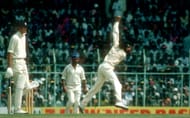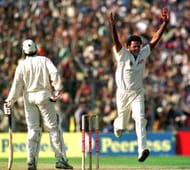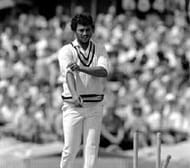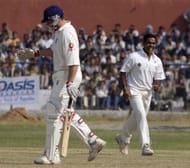Few teams have dominated the Indian domestic cricket scene like the Karnataka cricket team. Karnataka have won India’s toughest domestic tournament, the ‘Ranji Trophy‘ six times and have stamped their class as one of the toughest competitors in the Indian cricket scene.
A team is made up of several tough and dedicated individuals who will perform on the cricket field, but at the same time these players need to be supported by an administrative structure that will hold things together, behind the scenes. Karnataka cricket is administered by the Karnataka State Cricket Association (KSCA), which will be holding its Platinum Jubilee celebrations this year.
The KSCA originated in the year 1933-34, and has come a long way from starting at the modest Central College grounds office to now moving into the M. Chinnaswamy Stadium, its present headquarters and also one of the best cricket grounds in the world.
Similarly, many generations of Karnataka cricketers have passed us by over the years, cricketers who have provided yeoman service to Karnataka and have also gone on to represent India with distinction.
Here is a look at some of the best cricketers to have come out of the great state of Karnataka. The list is in no particular order and does not look to compare any performances. It is an effort to remember some of the legends who make us feel proud of being citizens of Karnataka.
1. Gundappa Viswanath
Gundappa Viswanath of India in action during the Fifth Test match against England at Chidambaram Stadium in Madras, India. 1982.
‘Vishy’, as he was called lovingly by his team mates, was one of the most respected batsmen of the 70s within the Indian team. His speciality lay in his ability to play the ball late, both off the speedsters and the spinners. The late cut was his favourite shot and he was arguably the best exponent of the shot of his generation.
Gundappa Viswanath scored a century on debut against the visiting Australians in 1969, at Kanpur. He went on to play 91 Test matches for India and scored at and average of 41.93, with 14 hundreds and 35 fifties. A record which has to be seen in perspective, as he played on uncovered pitches and against some of the fiercest bowlers of the time. His duel with Andy Roberts in Madras, where he scored a match winning 97, is spoken of as one of the best innings ever witnessed on India soil.
Another trait of ‘Vishy’ that usually goes unnoticed is his ability to score runs in extremely tough conditions. He was able to handle the West Indians in a tough series in 1978-79 in India and, at the same time, was able to score on green top wickets which he encountered in New Zealand in 1975-76. He has had duels with the best spinners of his time, such as Abdul Qadir and Derek Underwood, and has come out on top on most occasions.
A gentleman cricketer who epitomized the way cricket should be played, Viswanath was awarded the Col. C K Naidu Lifetime Achievement Award in 2009, in recognition of his contribution to cricket.
Sunil Gavaskar has on many occasions labelled Viswanath as the original ‘little master’.
2. Bhagwat Chandrasekhar

B S Chandrasekhar bowling, Tony Greig backing up and BS Bedi in background, India v England, 3rd Test, Madras, Jan 1976-77
B.S. Chandrasekhar was one of the important cogs in the famed Indian spin quartet of Bishen Bedi, E.A.S. Prasanna and S.Venkataraghavan, which dominated world cricket in the 60s and 70s. And without sounding prejudiced, it is widely accepted that on his day, Chandrasekhar was the most devastating.
A story of immense resolve, ‘Chandra’, as he was called by team-mates, was struck with polio as a child and his right hand was badly severed. With a situation that would leave most people looking at other prospects in life, Chandrasekhar was an exception. He went on to represent his country in 58 Test matches, and captured 242 wickets at an average of 29.74.
There were reports that he started playing cricket bowling in various styles, including medium pace. It may not be a coincidence, then, the concoction that he served up to the batsmen – which was a mixture of sharp googlies, leg breaks and top spinners at high speeds generally not expected from spinners.
Wisden awarded him with the ‘Best bowling performance of the century’ award in 2002, for his six wickets for 38 runs against England at the Oval in 1971, a performance that helped India win their first series in England.
Chandrashekar was also devastating in Australia in 1977-78, taking 12 for 104 at Melbourne. He picked 42 wickets in 5 Test matches abroad, making him one of India’s best bowlers in conditions outside India.
He was a tremendous bowler, with tremendous respect for him all over Karnataka and the entire cricketing world. You ask the West Indians, Australians or the English – they will tell you the story of ‘Chandra’.
3. Roger Binny
Roger Michael Humphrey Binny was the first cricketer of Anglo Indian decent to play for India. He made his debut for India at his home ground in Bangalore in 1979, against Pakistan, and made a good impression against the likes of Imran Khan.
Binny will always be remembered for his exploits in the 1983 World Cup, where he ended up as the highest wicket taker with 18 wickets and in the process helped India win their first World cup. Binny was always an under rated bowler, who generally bowled medium pace swingers dipping into and moving out from the batsmen. But if there was anything in the pitch, he would be your man to exploit it.
Binny had some notable performances in Test cricket both with ball and bat. The seven wickets that he picked up in the Test match against England at Headingley in 1986 and his 6 for 56 against Pakistan at Calcutta were notable, as was the unbeaten 83 he scored against Pakistan at Bangalore in 1983.
There is this continued talk in Indian cricket over who was the best all-rounder to have played for India after Kapil Dev. Roger Binny has strong credentials to stake a claim.
4. Javagal Srinath

Indian pace bowler Javagal Srinath (R) celebrates after trapping Pakistani batsman Salim Malik (L) leg before wicket on the third day of the inaugural match of the Asian Test championship between India and Pakistan at Eden Gardens
The ‘Mysore Express’ was a late discovery. Being a batsman in his youth, he has admitted to being unaware of the fact that he could bowl quick until much later, when he started playing club cricket. Luckily for India, he was spotted by Gundappa Viswanath and was picked to represent Karnataka.
Srinath is the fastest bowler that India has produced, and he consistently hit high speeds in the early parts of his career, though he did develop into a much more craftier bowler towards the later half.
Bowling booming in-swingers to the right handers and occasionally taking it away, he created immense problems for them. To the left handers though, Srinath was virtually unplayable. He troubled a seasoned batsmen like Allan Border in his debut series in Australia and earned high praise from the Australian captain, who earmarked him as a player to watch out for in the future.
In the One Day Internationals that followed, he was able to trouble the West Indian Brian Lara to no end, making the great man look amateurish at times.
Srinath represented India in 67 Test matches and picked up 236 wickets at a creditable average of 30.49. This is the highest number of wickets for an Indian fast bowler after Kapil Dev.
Javagal Srinath has also had an extremely successful ODI career, taking 315 wickets from 229 matches. Srinath took up the role of mentor to some of the younger Indian pace bowlers and was able to take India to the finals of the 2003 World Cup. In the company of Zaheer Khan and Ashish Nehra, the Indians had one of the best bowling attacks in the tournament.
Along with Venkatesh Prasad, he formed India’s best ever opening bowling combination, and working together, they were able to unsettle many an opposition. Srinath will always be remembered for being the lone warrior on the bare decks of the subcontinent, where he toiled manfully and proved that a fast bowler could indeed survive in India.
5. Sunil Joshi
The man from Gadag is a story of hard work, determination and true grit. It is said that Sunil Joshi used to travel about 60 kilometres by train all the way to Hubli for his cricket practice, and then return back to Gadag in time for school.
Joshi’s bowling action was a thing of beauty and extremely easy on the eye. He played the role of an ideal foil for Anil Kumble in the late 90s, a time when India’s bowling attack was comprised almost entirely of Karnataka cricketers.
Joshi represented India in 15 Test matches and 69 ODIs, and picked up 41 and 69 wickets in the respective formats. Joshi had best Test match bowling figures of 8/169 in two innings against Bangladesh in Dhaka, in a match where the hosts were threatening to stage a scare for India after scoring 400 runs in the first innings.
But Joshi shall always be remembered for a devastating spell he bowled against the South Africans in 1999, at the Gymkhana Club Ground, in Nairobi. He picked up five wickets for only six runs in the ten overs that he bowled, and all his wickets were of top and middle order batsmen. Wisden had rated this bowling performance as the seventh best bowling performance in One day International cricket at that point.
Joshi also has the distinction of picking up a rare double of 50 wickets and 500 runs in one domestic Ranji season. Joshi played over 18 years of Ranji cricket for Karnataka.
All those train rides were surely worth it, for Joshi, Karnataka and India.
Follow IPL Auction 2025 Live Updates, News & Biddings at Sportskeeda. Get the fastest updates on Mega-Auction and cricket news


